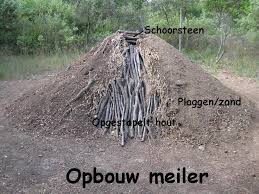Charcoal (Latin carbo) is by heat charred wood. By allow (almost) no oxygen to the wood it does not burn but water and volatiles extrude and forme (relatively pure) coal (dust). It looks like coal. It is a much more uniform product than wood and it burns better. There may be higher temperatures reached, along with a wood fire, and it was necessary to produce ore (primitive iron).
 To win a kilo of useful iron was about thirteen kilograms ore and one hundred and thirty kilograms of charcoal were needed. That means 760 kilograms of oak or about two to three oak trees. For one part of charcoal are about 4 parts of wood needed, one ton of charcoal requires 5 to 8 cubic meters of wood.
To win a kilo of useful iron was about thirteen kilograms ore and one hundred and thirty kilograms of charcoal were needed. That means 760 kilograms of oak or about two to three oak trees. For one part of charcoal are about 4 parts of wood needed, one ton of charcoal requires 5 to 8 cubic meters of wood.
Most used are oak, birch and alder. Making iron eats forests.
Wood consists for more than 40% of water that is in a network of cellulose and lignin molecules. Air dried wood still contains 12 to 18% water. That should all evaporate before the carbonization process can begin. This can by bringing the timber at a temperature of 100°C (or a little less). Thereafter, the temperature is raised to 280°C.
If the wood is dry and around the 280°C hot, it will fall apart into charcoal, water vapor, and various (complex) chemicals. There is a little air admitted, so there is some wood that remains burning to keep the initiated reactions running. Until here this process is controlled by adding heat.
Energy and heat are released at carbonization from 280°C. The reactions convert all substances in charcoal and stop around 400°C unless additional heat is added.
In addition to about 65 to 70% of solid carbon is tar (30%) and ash (2-5%) formed, depending on the degree of heating. Upon further heating the tar content decreases and the carbon content increases.
If charcoal is treated with oxygen is becomes very porous and is called activated charcoal (dust).
If you heat wood and distil the vapors, you get spirits, turpentine and coal tar. And charcoal of course.
Making charcoal
Cut the branches to size and put them together in a tin. Lid on top with a few holes in it. Put this 1.5 hours on a camp fire. After cooling, you can draw with charcoal.
In some (developing) regions is still working so effectively, albeit enlarged to a barrel on a firing pit.
You can dig a hole and fire it with the smallest timber down and fist thick stems on top. If it is burning, close the pit with sod (upper soil & grass layer) so that no oxygen comes in the fire and the wood chars.
In our environment charcoal burners made a charcoal pile (or clamp): a tipi or house of densely stacked thick branches in the middle of a recessed fireplace and chimney. The pile was covered with firmly packed damp sod.
Above and below are some air holes that remain open until the temperature is high enough. The charcoal-burner makes near the pile a small wood fire. The remaining of this charcoal is mixed with embers inserted into the openings of the pile. The glow of this cares for the start of combustion and carbonization process. Inside, the temperature can reach 1,000 degrees.
If the temperature is high enough, the holes are sealed to prevent the wood burns.
The right time to quit requires experience and knowledge of the charcoal burner. Eventually, the pile drops in up to one third of the initial height.
After 6 to 10 days it was completely burnt and all wood charred. It still needs to cool for a few days before it can be removed.
Instead of sod are also constructions of silt and clay built that can serve several times. If production goes wrong wood can burn complete, or the clay oven can explode.
Charcoal was from 1000 to 1918 a major component of gunpowder.
Charcoal is also useful as an adsorbent, e.g. as an antidote or to deodorize or decolourize.
